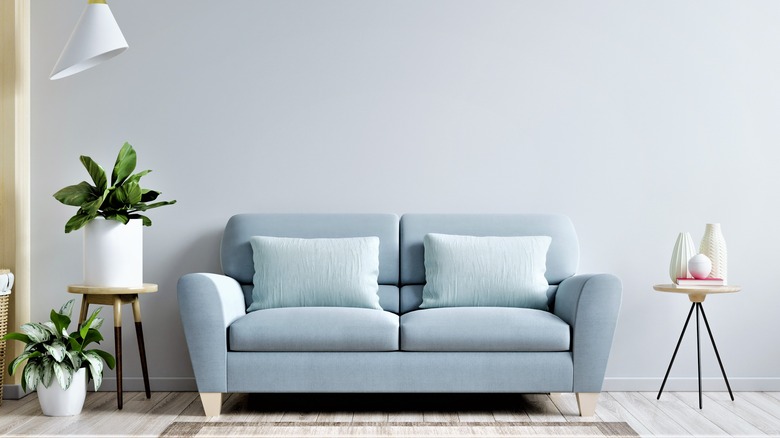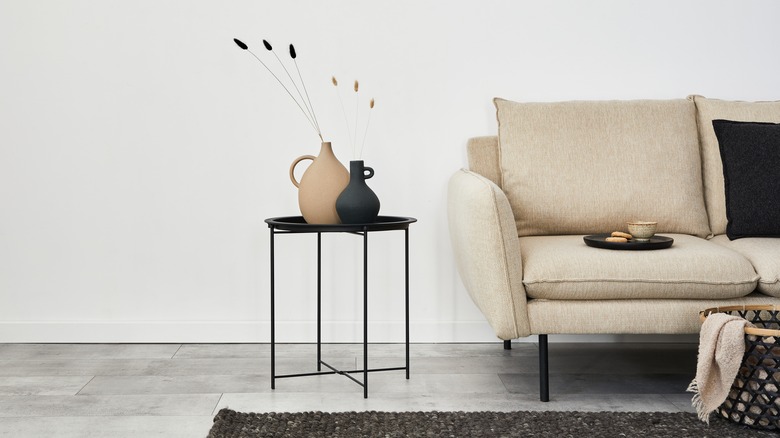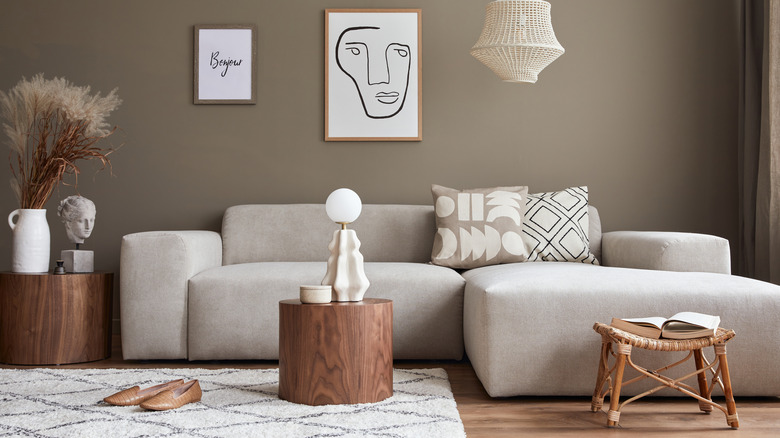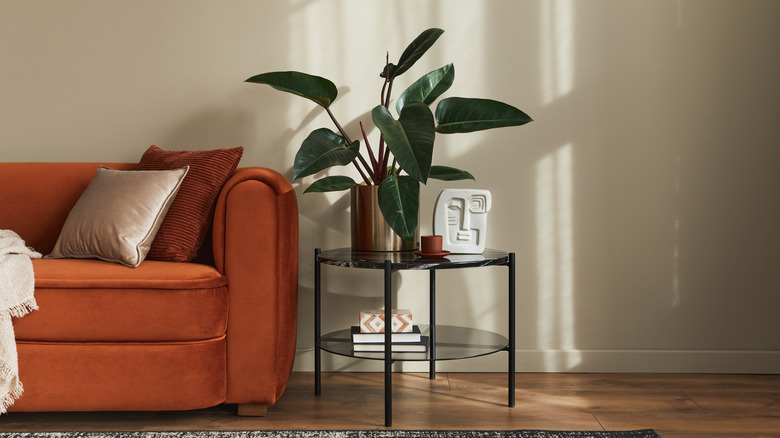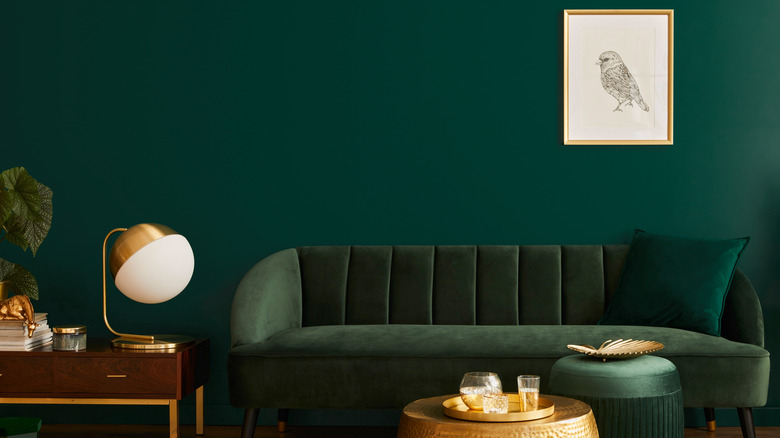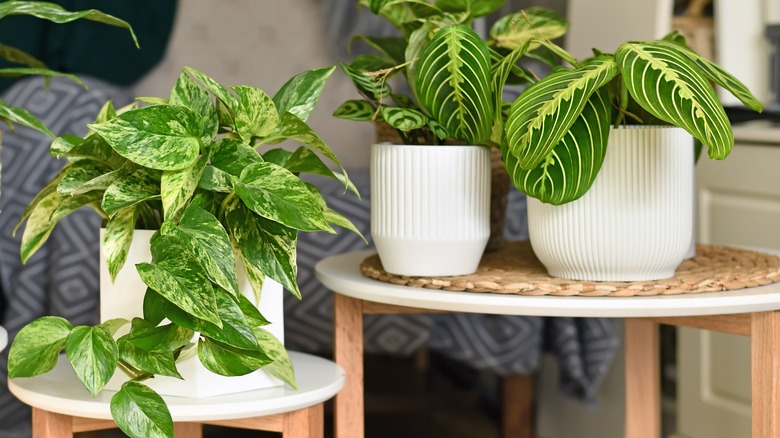Tips To Decorate Your Side Tables And Elevate Your Living Room Aesthetic
If you're redesigning your living room, styling your side tables is probably one of the last things you're worried about. Choosing wall art, furniture, and the layout of a space can take precedence over something as simple as the design of the pieces on a tiny table. However, the way you decorate this small piece of furniture will do more for your space than you may originally think. Overdo it and your living room could look cluttered; under-design it and your space could look empty.
In a design project at The Turquoise Home, an end table completed the living room's design. It added color, personality, and a place to set down glasses when relaxing on the couch. Additionally, the specific way the table was styled made the whole space look more cohesive and well-designed, and the design wasn't complicated at all: all it needed was three well-placed items.
Below are five tips on how to decorate your side table to elevate your living room aesthetic, too.
1. Keep it simple
When decorating a side table, make sure to keep the design simple. This will help you avoid a cluttered or chaotic look. In fact, Blesser House suggests only using three to five items, since the space is so small. Typically, these items will include a lamp, a personal item like a picture frame, and a plant or decorative piece. Additionally, remember that one of the uses of an end table is to hold a beverage glass or other things like a phone. Make sure you leave enough room on the surface for these items.
To corral smaller items, you could use a small trinket bowl or dish. Per Eliza Grace Interiors, you can use baskets to hold things like remotes, cords, or coasters. Choosing an end table with storage will also help you keep this space organized. If you're really limited on space, you could use the room around this piece of furniture for extra design elements. For instance, you could replace a table lamp with one on the floor, or you could bring the eye up with wall art above the table.
2. Think about the entire room's design
Before designing any specific space in a room, you should think about the entire room's design. The goal is to have your room feel like it flows together nicely, per Interior Cravings. To do this, add pieces to your side table that look cohesive with the room's color scheme, style, and overall feel.
According to furniture company Rooms To Go, balancing empty space with filled space will make a room's design look more appealing. Therefore, make sure the space around your side table is free from excessive clutter. Also, determine if the decorative pieces are adding texture and interest in the space. If not, you may want to reconsider the design.
Once you've completed the plans for your design, consider if it's either contributing or hindering the overall style in the space and make changes as needed. Having an end table that blends in with the rest of the room instead of standing out like a sore thumb will most likely be your goal (via Interior Cravings).
3. Use odd numbers and triangles
When choosing the right number of pieces for your table, you may want to stick with odd numbers. According to Kylie M. Interiors, abiding by the rule of odd numbers creates a balanced space, and arranging these items into the shape of a triangle will make them more visually appealing. Three items are typically used because they will naturally create the look of a triangle — but five could also be displayed.
To create the shape of a triangle, you'll need to choose pieces of various sizes and place the largest item in the back. This piece will function as the highest point on the triangle. Then, place the smaller items side by side in front. Per color expert Maria Killam, you should overlap these objects instead of leaving room between them. This will create a layered and dynamic look.
For instance, the DIY duo at Blesser House places a lamp behind a picture frame and a plant to create a triangle. They break the rule of odd numbers by adding a flat trinket dish in the front. However, it still looks cohesive in the space, because they created the shape of a triangle with the largest items.
4. Utilize lighting for more than just light
Most side tables hold a lamp that's used for reading or other tasks. However, your lamp should do more for your room than just provide extra light. It should also contribute to the overall style in the space. Home Stratosphere lists a number of different styles. A farmhouse lamp will utilize light colors and cottage-like designs. For a modern look, choose one with clean, straight lines. A mid-century modern style will have a unique shade and a basic base. Craftsman lamps have wide triangle shades and rustic elements. Tiffany designs have a stained glass shade and a metal base. Finally, an industrial look will have an exposed light bulb and a metal base.
Fine Home Lamps offers more lamp considerations. When choosing the size, keep your end table in mind. A large lamp will overwhelm a small table, while a small lamp may look understyled on a larger piece of furniture. If your table is tall, choose a shorter lamp — and don't choose a shade that's wider than your table. Finally, ensure the style of the lamp and the style of the table are cohesive; while they don't have to match perfectly, they should look appealing when used together in the room.
5. Add natural elements
To add warmth and an inviting feel to your living room, include natural elements on your side table. The most popular element to add is a plant. Crate & Barrel says that you should first think about how much light the plant will get. If your end table isn't in natural lighting, you should choose a species that thrives in the shadows. Also, consider the size of the plant. Don't choose one that's too large, as this could overwhelm your living room. Some unique ideas include using a teacup as a planter or draping a trailing vine down the side of the table.
There are other ways to add natural elements to your living room, too. Per Vintage MillWerks, your side table itself could add warmth to your space, if it's made of wood. Fresh flowers arranged in a vase could add life to your room. Stone elements can give an earthy feel as well.
